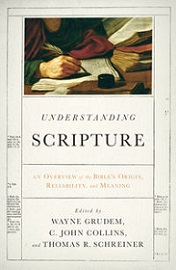 “How do we know the Bible is historically accurate?” “How were books of the Bible collected, and how do we know some books weren’t left out?” “Why don’t we consider the Apocrypha a part of the Scriptures?” These honest questions from both members and prospects cannot be easily answered in a few sentences. Though a pastor might refer to his seminary notes or an essay in the three volume NPH set Our Great Heritage, he may not have a book on his shelf to provide a simple but satisfactory answer. If that’s the case, Understanding Scripture is a useful reference tool to answer such questions. This book is a compilation of eighteen essays written by well-respected scholars from a variety of denominations. It aims to provide “an overview of the Bible’s origin, reliability, and meaning.”
“How do we know the Bible is historically accurate?” “How were books of the Bible collected, and how do we know some books weren’t left out?” “Why don’t we consider the Apocrypha a part of the Scriptures?” These honest questions from both members and prospects cannot be easily answered in a few sentences. Though a pastor might refer to his seminary notes or an essay in the three volume NPH set Our Great Heritage, he may not have a book on his shelf to provide a simple but satisfactory answer. If that’s the case, Understanding Scripture is a useful reference tool to answer such questions. This book is a compilation of eighteen essays written by well-respected scholars from a variety of denominations. It aims to provide “an overview of the Bible’s origin, reliability, and meaning.”
In the first third of the book, the essayists explain how to interpret and apply the Scriptures properly. The second third of the book gives an overview of the formation of the Old and New Testament canon, the reliability of the Old and New Testament manuscripts, as well as a summary of how archeology affirms the Scriptures’ reliability. The final third of the book gives a basic summary of the biblical languages, the origin and importance of the Septuagint, and how the New Testament quotes and interprets the Old Testament.
What I found most helpful about the book was how clear and concise the chapters were. In just seven to nine pages, the essayists provide in depth, yet understandable overviews on each of the topics. For example, after answering three critical views of how the Old Testament canon was compiled, Roger Beckwith ends his essay with a simple twelve point historical summary of why we can be sure the Hebrew Old Testament contains the true canon.
Secondly, I also appreciated how balanced the authors were in their overviews of complex topics. Here are a few examples:
In his essay on the reliability of the New Testament manuscripts Daniel Wallace highlights the number and antiquity of manuscripts compared to other literature, as well as how minor the variants are. Yet at the same time he acknowledges that there are thousands of wording differences (112) and that “even the closest two early manuscripts have at least half a dozen differences per chapter” (111).
David Chapman’s essay on New Testament archeology was also insightful. Although Chapman stresses the amazing accuracy of geography in the books of John and Acts, he also acknowledges that “most dating methods require some degree of interpretation” and that our “knowledge of most ancient places is limited” (128).
In his essay on the Greek language, David Alan Black cautions against seeking the meaning of a Greek word from its root rather than from the context. He also stresses that vocabulary words like agapao/phileo and oida/ginosko may be “used interchangeably without any significant difference in meaning” (153). So, he wisely warns Greek students not to read too much into the original text.
Finally, though these essays were written by scholars from outside our Lutheran circles, thankfully the evangelical errors we might expect to find were lacking. In his essay on reading the Bible for personal application, David Powlison strongly asserts, “Nothing in the Bible was written directly to you or specifically about what you face…The Bible is primarily about God, not you” (53). In his chapter on interpreting the Bible, Daniel Doriani insists that the main point of the Abraham-Isaac account and the David-Goliath narrative are not “‘Abraham obeyed a hard command and believers should too’ or ‘David was brave and Christians should be too.’ The lessons are that ‘The Lord provides’ and ‘the battle is the Lord’s’” (16). Even in a chapter entitled “Reading the Bible in Prayer and Communion with God” where one might expect some questionable applications, John Piper instead writes “we go astray if we make the daily experience of God the basis of our communion with him. We know God for who he is when we meet him through his Word” (48).
Though the opening chapters on interpreting and applying the Bible were refreshing to read, admittedly the Lutheran pastor who reads those essays won’t learn anything new. But the chapters on the manuscripts and canon, the Septuagint, Apocrypha, and archeology make Understanding Scripture a handy reference tool. These scholarly summaries in just a few pages provide simple and straightforward answers to questions about the Bible’s origins. These provide what a busy pastor might be looking for—an overview.
Wayne Grudem is a prominent evangelical theologian, seminary professor, and author. Since 2001, he has been the Research Professor of Theology and Biblical Studies at Phoenix Seminary in Phoenix, Arizona. C. John Collins is professor of Old Testament at Covenant Theological Seminary in St. Louis, where he has served since 1993. Grudem was the general editor of the ESV study Bible and Collins was the Old Testament editor. Thomas Schreiner is Professor of New Testament Interpretation at the Southern Baptist Theological Seminary in Louisville, Kentucky.

